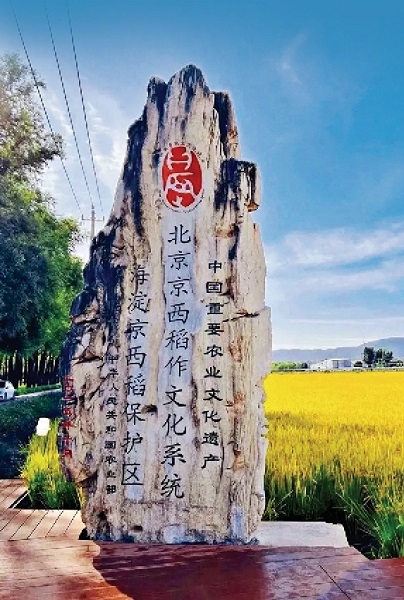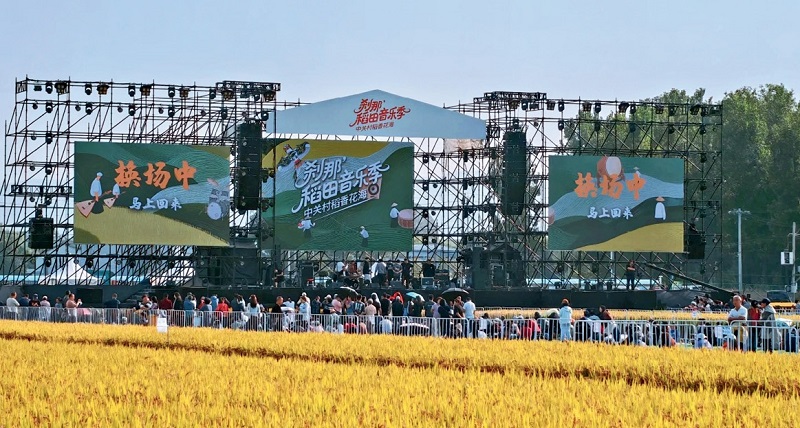
The Beijing Jingxi Rice Cultural System was included in the third batch of China’s Important Agricultural Heritage Systems in 2015, underscoring the government’s commitment to its preservation.
Who would have thought that on the very edge of western Beijing, this veritable megacity, lies a spectacular stretch of rice paddies?
Under the early autumn sun, rice fields in the protected Jingxi Rice planting area of Shangzhuang Town resemble a golden brocade spread across the land, swaying gently in the wind. Deep in the fields, flocks of birds – including endangered ones – skim lightly over, pause among the rice, or lower their heads to forage.
Peng Tao, an avid bird watcher from the Haidian District Wetland and Wildlife Protection Management Center, has been monitoring this core planting area of Jingxi Rice for a long time. He reported that since the beginning of this spring, a cumulative total of 90 different bird species have been observed and recorded in this area. Among these, there were rare birds such as the globally critically endangered Yellow-breasted Bunting and the Relict Gull, both first-class nationally protected wildlife in China.
Jingxi Rice originated as an imperial rice variety selected and cultivated by the Qing Dynasty (1644-1911) royal family, planted around Yuquan and Wanshou mountains near or inside the Summer Palace and was used as tribute rice to the court. Later, with the urbanization drive around the turn of the century and growing water scarcity, its planting areas gradually began to shrink and be restructured. Today, Jingxi Rice has been recognized as an important agricultural cultural heritage item in China and officially established its home in Shangzhuang Town, Haidian District in northwest Beijing.
Imperial Origins
The history of Jingxi Rice can be traced back over 300 years to the Qing Dynasty (1644-1911), when after Emperor Kangxi’s (1654-1722) southern inspection tours, he took back high-quality rice seeds for trial planting at the foot of Yuquan Mountain in the western suburbs of Beijing. This established a royal tradition of rice planting that continued through the reigns of his successors, including Yongzheng (1678-1735) and Qianlong (1711-1799).
The natural environment there was favorable for rice planting: the broad valley lowlands at the foot of the mountain shore up abundant water sources. Furthermore, extensive water conservancy projects were undertaken during the Qianlong era, diverting water from over thirty springs nearby. Water collected eventually flowed into Kunming Lake in the Summer Palace, making the lake the primary water source for irrigation.
Emperor Qianlong’s poem, “To irrigate the rice fields and avoid drought, it is no harm to delay the pleasure of boating,” reflects upon how he postponed a boating trip on Kunming Lake during the irrigation season for Jingxi Rice since cherishing agriculture was a basic governing principle.
Today, the stone water channels in the Fragrant Hills of Beijing, the construction of which was ordered by Emperor Qianlong, still remain in use.
Also in use today are the “Yellow Jackets” bestowed by the emperor. It is said that Qianlong sent people to select thirteen expert rice growers from south of the Yangtze River delta (the hometown of rice), relocated them to the royal capital, and awarded them Yellow Jackets as an encouragement. This royal acknowledgement and recognition became a cherished heritage and yellow jackets are still worn today by Jingxi Rice growers in Liulangzhuang Village, Haidian District.

The Jingxi Rice fields located in the protected planting area of Shangzhuang Town, Haidian District in Beijing resemble a golden blanket spread across the land on October 11, 2025.

Technology Empowerment
Growing up in a village in northwest Haidian District, Du Zhendong, now president of the Jingxi Rice Culture Research Association, harbors lots of childhood memories about the rice paddies.
“Jingxi Rice is a high-quality, round-grained, non-glutinous rice strain. Currently, there are around 133 hectares of it grown in Haidian District with Shangzhuang Town as the main production area. The town has made significant investments to ensure its continuous cultivation,” said Du.
According to Du, at the Jingxi Rice Smart Farm in Shangzhuang Town, where 27 hectares of Jingxi Rice is grown, rapid technological advancement has worked wonders.
Leveraging the innovation strengths of the Zhongguancun Science Park nearby, the town has collaborated with UML Tech Co. to introduce advanced smart agricultural machinery. By utilizing technologies such as the Internet of Things (IoT), GPS, AI, and 5G, along with high-precision sensors deployed across the rice fields, the farm enables real-time monitoring of crop growth conditions.
In addition to the mechanical giants operating on the ground, those taking to the skies are also indispensable. For example, pesticide spraying over a given area that once required several days of manual labor can now be completed by unmanned aerial vehicles in just tens of minutes, greatly reducing human labor and improving efficiency.
Technology not only boosts agricultural yields but also meticulously safeguards the ecological environment. Smart irrigation systems deliver water on demand to avoid wasting water resources. Precision chemical application has improved the utilization efficiency of agrochemicals, minimizing as far as possible harm to beneficial insects; routine sample inspections of the irrigation river conducted by the local water authority also ensures healthy growth.
“A symbiotic and harmonious relationship among humans, animals, plants, and microorganisms in these fields is what I hope for,” said Du.
From Textbook Knowledge to Practice
Every autumn during the harvest season, Shangzhuang Town hosts a variety of cultural activities to attract city dwellers.
The Rice Harvest Festival is the most popular one. After harvesting the rice, adults and children alike pick up small buckets and wade into the water to nab crabs.
“For teenagers and children raised in the city, vast golden rice fields and the sight of harvesting with a sickle are entirely novel,” said Du. They’ve never understood the intricacies of the harvest, nor have they truly grasped the profound meaning behind “every grain comes from hard work.” Here, through hands-on experience, they learn a unique and invaluable life lesson.
Here, children also get to see how the straw left from last year’s harvest is put to use. Besides being used as fodder, fuel, and fertilizer, it is widely utilized for weaving and building materials. This helps turn the knowledge in their textbooks into vivid reality.
Additionally, a music festival is another delight. In early October, a two-day “Rice Field Music Festival” was held here. Themed around “Rice Fields × Natural Healing,” the festival not only provided a unique autumn experience but also showcased the innovative achievements of Shangzhuang Town in integrating agriculture, culture, and tourism.
“These activities combine tourism, shopping, and entertainment – and while promoting Jingxi Rice culture, they also serve as a grand stage for township enterprises to showcase high-quality agricultural products. This event has transcended mere agriculture or heritage by elevating the Jingxi Rice planting into a matter of history, culture, nostalgia, and a cherished memory for old Beijingers,” said Du.

Attendees to the 2025 Rice Field Music Festival from October 6 to 7 relish the lovely, fragrant smell and view of rice fields surrounding them in Shangzhuang Town, Haidian District.

Showcasing Jingxi Rice Beyond the Fields
In 2015, the Beijing Jingxi Rice Cultural System was included in the third batch of China’s Important Agricultural Heritage Systems, underscoring the government’s commitment to its preservation.
To promote Jingxi Rice and make it known to more people, Du dedicated years to developing potted rice – a novel cultivation approach aimed at transforming the grain into an ornamental plant and unlocking value beyond traditional food use.
In 2023, potted Jingxi Rice made a symbolic urban debut: during National Day celebrations, it was featured in a “Common Prosperity” themed floral arrangement as an emblem of modern suburban agriculture on Chang’an Avenue near Tiananmen Square.
“This was a rare opportunity to raise its profile,” remarked Du. “Introducing potted rice into urban settings is an effective way to advance the integration of agriculture and city life,” Du noted.
Extensive preparation preceded its unveiling. Du and his team optimized the pot design to balance plant health and portability, experimenting repeatedly with size and materials. The nutrient soil formulation – composed of recycled rice hulls, organic fertilizers, and slow-release nutrients – resulted in pots two-thirds lighter than traditional soil-based versions. “Even a primary school student can carry them,” Du noted. “This lightness significantly enhances its potential as an ornamental plant.” Beyond that, Du’s team has also proceeded to develop value-added products such as Jingxi Rice wine, rice cakes, and beverages. “Once reserved for imperial courts, these delicacies are now accessible to everyone,” he added. 